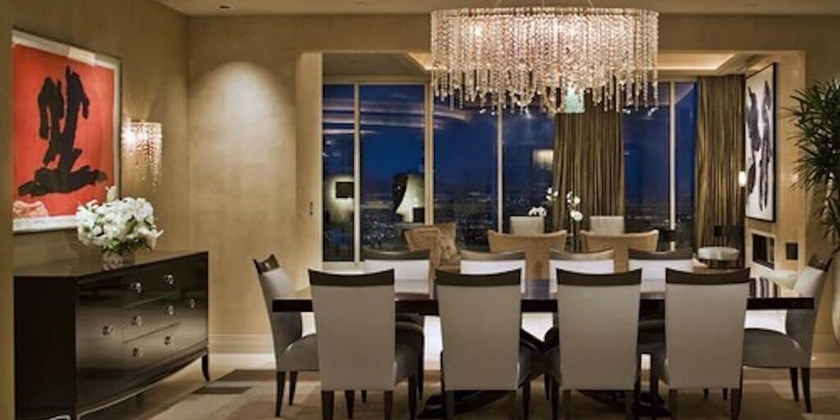LED Spotlight: The Best Light to Dine By
Aug 12th 2020
Whether you have a large formal dining room or a nook in the kitchen where you have a table and chairs, the one thing every dining area needs is good lighting. We’ve talked about the importance of layering your lighting in previous posts. See these about ambient lighting, task lighting, decorative lighting, and accent lighting here. In this post we’ll talk specifically about how each of these layers comes together to create the perfect dining room lighting experience.
As we’ve seen before, many fixtures can actually provide a variety of different kinds of light depending upon how they’re being used in a given situation. These layers are not entirely distinct and they can overlap.
Let’s start with the obvious: task lighting. The primary reason for sitting at your dining table is likely to eat a meal. But, as in a restaurant, if you can’t see what you’re eating, or if the colors are off because of low light quality, eating at your table is not going to be a pleasant experience. Improperly positioned lights will cast inconvenient shadows while lights with a poor CRI rating will make food look unappetizing. Your intuition likely tells you that a light positioned above the table or eating surface is the best way to counteract that. And you’d be right! But what is the correct positioning for these lights? Luckily there’s a simple equation to figure this out.
In order to choose the proper light for your space and position it appropriately, consider the following:
Chandelier fixtures
These are the most common dining room fixtures and are likely what you picture in your head when you think of a traditional dining room setup. Lighting your table with a chandelier is fairly simple, but there are a few simple things to keep in mind when planning your chandelier for your space and your kind of table. So how can you tell what size chandelier you need for your table? Let’s look at some examples below.
Shade diameter should be between 1/3 to 2/3 of the table’s length
Table clearance height of a minimum of 24 inches
Length or diameter of table = 48 inches
48 inches / 3 = 16 inch diameter (minimum)
48 inches / 3 x 2 = 32 inch diameter (maximum)
Ceiling pendants
Lighting a long table with just a single fixture can be a challenge and often doesn’t provide sufficient light for everyone. It is advisable to light a long table with multiple ceiling pendant fixtures. However, knowing how many you need and how far apart to place them can feel daunting, but it doesn’t need to. Here is a handy formula you can use to ensure you have the perfect amount of light for any size table or space.
A few things to keep in mind as we work through this example:
Width of shade should be no more than half the distance of the hanging width apart.
Shades should be no wider than 1/3 the width of the table
Table clearance high, minimum of 24 inches
Length of table divided by number of pendants +1 = width apart (from central point)
Width of table = 48 inches
Pendants required : 3 (plus 1 per equation above) = 4
48 in / 4 = 12 in
Ceiling pendants should be hung 12 inches apart (from the central point)
Shade width maxim = 12 / 2 = 6
Shade diameter maximum = 6 inches
One last thing to consider with task lighting for a dining room is that many chandeliers and even some pendants can wind up shining just as much (if not more) light toward the ceiling as down at your food. This simple fact means that while a chandelier is likely going to be your main source of task light in your dining room, it is also a powerful source of ambient and even decorative light.
Ambient light is important in any room, it provides the majority of the light you need to simply not bump into things or see the people you’re talking to. Your dining room’s chandelier may be its primary task light, but it may be the room’s primary source of ambient light as well. Other excellent sources of ambient light for dining rooms are wall sconces and table or floor lamps. If you live in a rental unit and are unable to rewire your dining room lighting, there are plug-in wall sconces on the market that can be easily installed with a few screws and plugged into any 120-volt outlet.
Your chandelier or pendant lights may also be the primary focal point of your room and the primary source of decorative light. Decorative light doesn’t have to be ostentatious. Depending upon your style, it can be subtle, classic, modern, retro, DIY, etc. The possibilities are endless. Wall sconces and lamps can also be sources of decorative light.
Ultimately the best light to dine by is layered, versatile, adjustable, and high quality. Layer your lighting by balancing your ambient, task, and decorative lighting. Ensure that you can control your various lighting elements separately. You may want to use only wall sconces, a combination of sconces and lamps, just the ceiling fixture, or any other combination of your lights. Dimmer switches for chandeliers and sconces will help you create the perfect atmosphere for any meal. Quality is important. You need light that’s sufficiently bright and also has a high enough CRI so that colors are rendered accurately.
No matter what your fixture, SunLake Lighting has the bulbs you need. All our LED bulbs have an expected lifespan of at least 20 years and a CRI of 80+, so your meals will look as good as they taste for years to come.
Below are just some of the bulbs SunLake carries that will make all the difference in your dining space. For SunLake’s full catalog of lights, click here.


